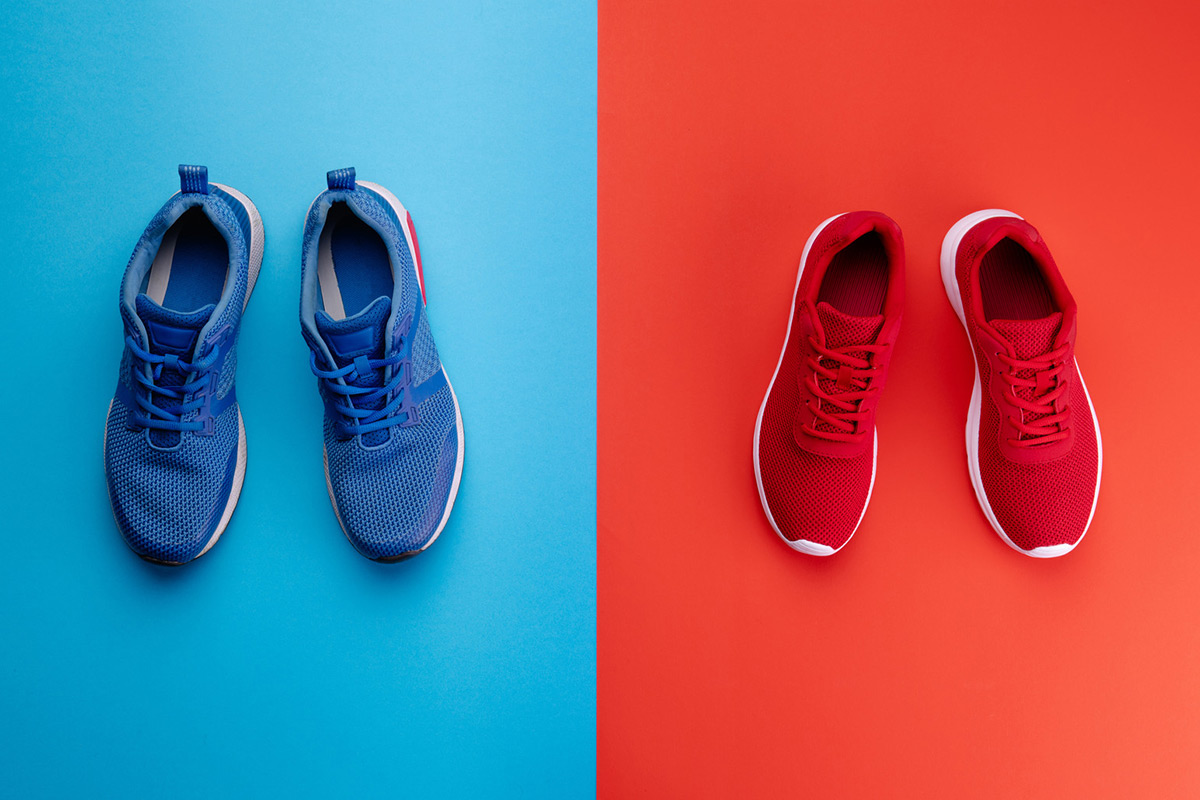Table of contents
Exercise is a great way to burn calories and maintain a high level of fitness for overall health benefits. When exercising, it’s essential to have the right kind of gear to optimize your workout session, and that includes having the right type of shoes. Here’s a deeper look at the differences between training shoes and running shoes.

© Can Stock Photo / halfpoint
Training Shoes
Training shoes are designed for efficient support for a variety of exercises. They offer versatility by catering for different kinds of movements, particularly lateral movements, and are perfect for gym workouts.
- Materials – To provide the much-needed support during exercise, training shoes feature sturdy materials given that training exerts loads of force on shoes. Additionally, they incorporate breathable materials for proper ventilation. During exercise your feet sweat substantially, and breathable training shoes help to maintain a cool and comfortable environment for your feet. A breathable mesh upper helps create an airflow channel to keep your feet feeling fresh even when things get heated.
- Size and Weight – Training shoes tend to be slightly heavier than running shoes, and it’s for good reason. By incorporating a heavier build, training shoes offer greater support and stability. This feature is particularly helpful given the variety of exercises you’d opt to do at the gym.
- Comfort – To ensure maximum comfort, training shoes have a cushioning system in place. Trainers feature more of a forefoot cushioning to protect your feet, as you tend to land more on your toes during gym sessions. This cushioning makes activities such as jumping rope or weight lifting all the more comfortable. A comfy upper coupled with a flexible mid-sole adds to the cushioning effect.
- Shock absorption – The gel cushioning system not only provides comfort but also helps to reduce the shock associated with short bursts of workout sessions. The shock absorption feature ensures that the shoes maintain their shape under heavy compression cycles.
- Support – Training shoes incorporate grooves and outsole designs that offer multi-directional movement and support during plyometric (powerful aerobic) exercises. The distinct design makes trainers a versatile option, ideal for a variety of workouts. Additionally, a lower heel drop design brings the shoe closer to the ground, creating a pivot to help you push off easier.
One of my favorite training shoes are my pair or Nike Air Max 97 Plus !
Running Shoes
Running shoes have several features that differentiate them from training shoes. With running shoes, you ideally want a shoe that’s more tailored towards conquering longer distances.
The consistent strides associated with running necessitate a different approach when designing these types of shoes.
- Materials – A majority of running shoes are made with breathable nylon mesh or knit polyester. The knit polyester gives the shoes a smooth finish. The upper may also feature poly-urethane leather attachments to offer waterproof functionality and give the shoes a greater ability to stretch.
- Comfort – Since running involves long periods of high impact exercise, running shoes offer extra protection in the form of extra cushioning. This cushioning is more present around the foot and in the insole as well.
- Footbed – The footbed of running shoes should feel firm but still be able to absorb most of the impact when your foot hits the ground. Typically the footbed features a large heel drop, meaning the heel of the shoes is thicker. The heel should measure anywhere from eight to ten millimeters for effective cushioning.
- Breathability – Running shoes often feature a perforated upper to add to the aeration of the shoes. Given the fact that the upper is in constant contact with your foot, it tends to feel hotter than the rest of the shoe and therefore ventilation is essential. Running shoes are also more spacious inside compared to training shoes, to offer a cooler effect over long runs.
- Durability – The lifespan of running shoes is a critical part of their design, and that’s why running shoes feature a variety of traits that add to their sturdiness. The upper typically features synthetic or fabric overlays to add flexibility and thickness to the shoe. The midsole also comes with firm materials such as polyurethane to offer resistance against repeated compression stress. The outsole incorporates a mix of hard rubber for the rearfoot and soft rubber for the forefoot.
Conclusion
Choosing the right type of shoe for your workout sessions is critical in achieving the desired workout results. The wrong type of shoes could lead to a variety of complications, including lower performance, discomfort, or worse still, injuries. Having the right type of shoe for your workout also goes a long way in avoiding instances of swollen feet or blackened toenails.
So, if you’re more of the cross-training type, training shoes are an excellent choice, thanks to their heavier weight and flatter soles. If you aim to run 5Ks or 10Ks occasionally, then running shoes are the ideal go-to option, given their durability and resilience during running exercises. It all comes down to your preferred workout regimen.
Resources:
- crossfitsurvival.com/running-shoes-vs-training-shoes/
- garagegympower.com/cross-training-shoes-vs-running-shoes/
- asics.com/us/en-us/blog/article/running-shoes-vs-training-shoes
